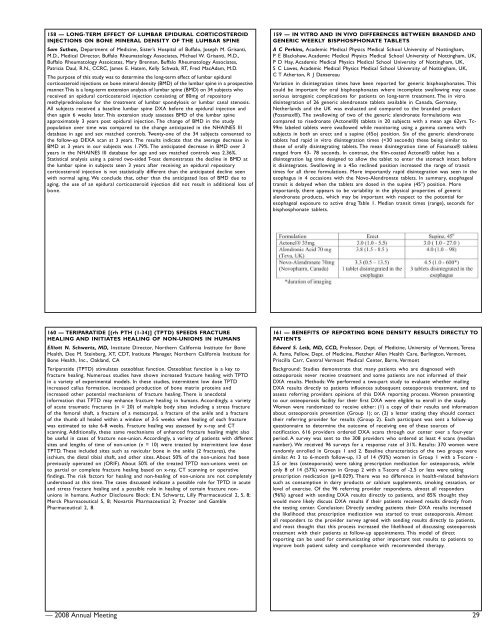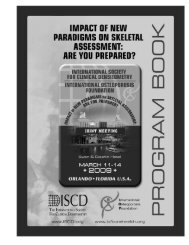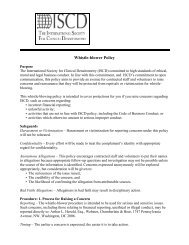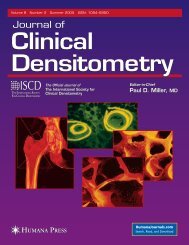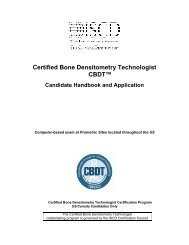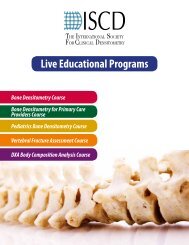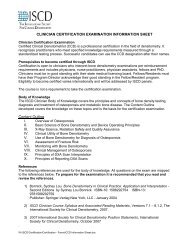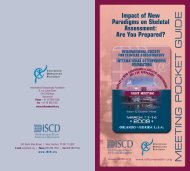Program Book and Abstracts - ISCD
Program Book and Abstracts - ISCD
Program Book and Abstracts - ISCD
Create successful ePaper yourself
Turn your PDF publications into a flip-book with our unique Google optimized e-Paper software.
158 — LONG-TERM EFFECT OF LUMBAR EPIDURAL CORTICOSTEROID<br />
INJECTIONS ON BONE MINERAL DENSITY OF THE LUMBAR SPINE<br />
Sam Suthan, Department of Medicine, Sister’s Hospital of Buffalo, Joseph M. Grisanti,<br />
M.D., Medical Director, Buffalo Rheumatology Associates, Michael W. Grisanti, M.D.,<br />
Buffalo Rheumatology Assoicates, Mary Brennan, Buffalo Rheumatology Associates,<br />
Patricia Daul, R.N., CCRC, James E. Hatem, Kelly Schwab, RT, Fred MacAdam, M.D.<br />
The purpose of this study was to determine the long-term effect of lumbar epidural<br />
corticosteroid injections on bone mineral density (BMD) of the lumbar spine in a prospective<br />
manner. This is a long-term extension analysis of lumbar spine (BMD) on 34 subjects who<br />
received an epidural corticosteroid injection consisting of 80mg of repository<br />
methylprednisolone for the treatment of lumbar spondylosis or lumbar canal stenosis.<br />
All subjects received a baseline lumbar spine DXA before the epidural injection <strong>and</strong><br />
then again 6 weeks later. This extension study assesses BMD of the lumbar spine<br />
approximately 3 years post epidural injection. The change of BMD in the study<br />
population over time was compared to the change anticipated in the NHAINES III<br />
database in age <strong>and</strong> sex matched controls. Twenty-one of the 34 subjects consented to<br />
the follow-up DEXA scan at 3 years. The results indicate that the average decrease in<br />
BMD at 3 years in our subjects was 1.79%. The anticipated decrease in BMD over 3<br />
years in the NHAINES III database for age <strong>and</strong> sex matched controls was 2.36%.<br />
Statistical analysis using a paired two-sided T-test demonstrates the decline in BMD at<br />
the lumbar spine in subjects seen 3 years after receiving an epidural repository<br />
corticosteroid injection is not statistically different than the anticipated decline seen<br />
with normal aging. We conclude that, other than the anticipated loss of BMD due to<br />
aging, the use of an epidural corticosteroid injection did not result in additional loss of<br />
bone.<br />
159 — IN VITRO AND IN VIVO DIFFERENCES BETWEEN BRANDED AND<br />
GENERIC WEEKLY BISPHOSPHONATE TABLETS<br />
A C Perkins, Academic Medical Physics Medical School University of Nottingham,<br />
P E Blackshaw, Academic Medical Physics Medical School University of Nottingham, UK,<br />
P D Hay, Academic Medical Physics Medical School University of Nottingham, UK,<br />
S C Lawes, Academic Medical Physics Medical School University of Nottingham, UK,<br />
C T Atherton, R J Dansereau<br />
Variation in disintegration times have been reported for generic bisphosphonates. This<br />
could be important for oral bisphosphonates where incomplete swallowing may cause<br />
serious iatrogenic complications for patients on long-term treatment. The in vitro<br />
disintegration of 26 generic alendronate tablets available in Canada, Germany,<br />
Netherl<strong>and</strong>s <strong>and</strong> the UK was evaluated <strong>and</strong> compared to the br<strong>and</strong>ed product<br />
(Fosamax®). The swallowing of two of the generic alendronate formulations was<br />
compared to risedronate (Actonel®) tablets in 20 subjects with a mean age 62yrs. Tc-<br />
99m labeled tablets were swallowed while monitoring using a gamma camera with<br />
subjects in both an erect <strong>and</strong> a supine (45o) position. Six of the generic alendronate<br />
tablets had rapid in vitro disintegration times (


